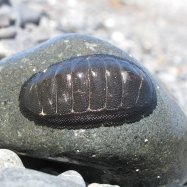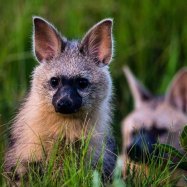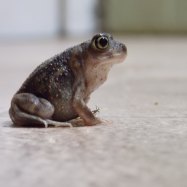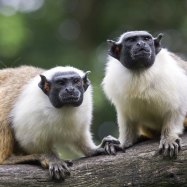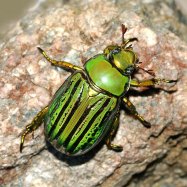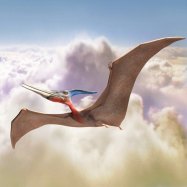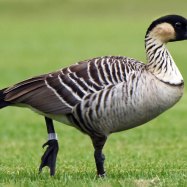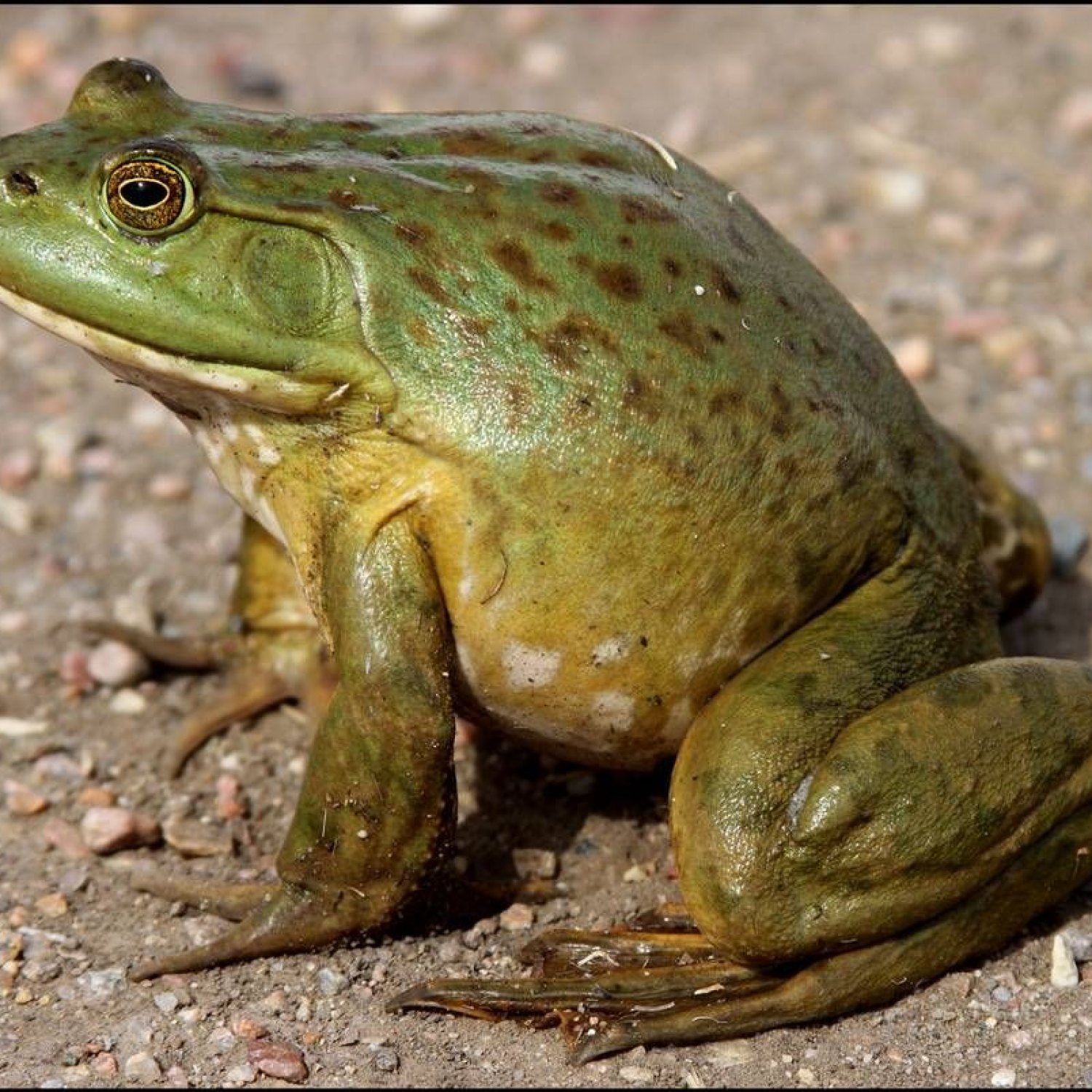
Bullfrog
4-8 inches (10-20 cm)
The bullfrog, found in North America, is a large and stocky amphibian belonging to the Ranidae family. Known for their distinctive croaking sound, these animals can grow up to 4-8 inches in length. Despite their size, they are excellent jumpers and have a diverse diet, making them an important part of their ecosystem. Keep an eye out for these charismatic creatures in ponds, lakes, and marshes. #Bullfrog #NorthAmerica #Amphibians
Animal Details Summary:
Common Name: Bullfrog
Kingdom: Animalia
Habitat: Lakes, ponds, rivers, marshes
The Mighty Bullfrog: The Powerful Amphibian of North and South America
As you take a stroll by a peaceful lake, you may hear a distinctive, loud croaking sound coming from the water. You look around and soon spot a large, stocky creature sitting on a lily pad, with its sleek body, bulging eyes, and vibrant green or brown color. This is none other than the mighty bullfrog, also known as the Lithobates catesbeianus, a powerful amphibian found in the lakes, ponds, and rivers of North and South America.The Kingdom of Bullfrogs
The bullfrog is a member of the Animalia kingdom, which includes all animals on Earth Bullfrog. Within this kingdom, it belongs to the Chordata phylum, which comprises organisms with a spinal cord. Its class, Amphibia, consists of animals that can live both on land and in water, like frogs and toads.
The Order of Anura and the Ranidae Family
Within the class of amphibians, the bullfrog belongs to the order Anura, which translates to "without a tail." This order includes over 7,000 different species of frogs and toads, with the bullfrog being one of the largest members. It is also a part of the Ranidae family, which includes over 600 different species of true frogs.
The Bullfrog's Habitat
Bullfrogs are commonly found in the lakes, ponds, rivers, and marshes of North and South America. They prefer still or slow-moving bodies of water with plenty of vegetation, as it provides shelter and food. They are also tolerant of a wide range of temperatures, making them adaptable to different habitats.
Carnivorous Creatures
One of the most interesting things about bullfrogs is their feeding method Booby. They are carnivorous, meaning that they feed on other animals. These creatures have a voracious appetite and are known to eat worms, insects, spiders, small fish, and even other frogs.
Their hunting technique is swift and efficient - they lay in wait for unsuspecting prey to pass by, and with one quick strike of their powerful jaws, they catch their meal. Interestingly, bullfrogs can also eat larger prey by stretching their muscular stomachs to accommodate it.
The Geographical Distribution of Bullfrogs
Bullfrogs are native to North America and can be found in all 50 states of the United States, as well as in Canada and Mexico. However, they have also been introduced to other parts of the world, including Europe, Asia, and South America, due to their popularity as pets and for consumption.
Their tendency to reproduce rapidly and their adaptability to different habitats has led to a rise in their population in these introduced areas, causing concern in terms of their impact on native species. As a result, some countries have banned the import and possession of bullfrogs.
Captivating Coloration and Body Shape
Bullfrogs have a remarkably unique coloration, with their skin ranging from shades of green to brown. This coloration acts as camouflage, helping them blend into their surroundings and escape from potential predators.
In addition to their coloration, the bullfrog has a large, stocky body. On average, they can grow to be 4-8 inches (10-20 cm) long, although some can reach up to 12 inches (30 cm) in length. Their bodies are designed to be powerful swimmers, with their strong hind legs and webbed feet helping them move quickly through the water.
The Life of a Bullfrog
A bullfrog's life cycle begins as a tadpole, which hatches from its egg in the water. The tadpole then slowly develops into a frog, growing hind legs first, and then their front legs and lungs. This process can take anywhere from 12 to 16 weeks, after which the froglet will leave the water and begin its life on land.
Bullfrogs can live up to 10 years in the wild, and during this time, they play a crucial role in their ecosystem. Apart from being voracious predators, they also serve as prey for other animals, such as birds, snakes, and larger frogs.
The Importance of Conservation
The bullfrog is an important species for the health of the environment it inhabits. Their presence helps control the population of insects and smaller animals, preventing them from becoming pests. They also serve as an indicator of the health of the ecosystem they live in, and any decline in their numbers can suggest larger problems.
However, due to humans' impact on the environment, bullfrog populations are facing significant threats. One of the biggest threats they face is habitat destruction, as human activities such as urbanization and pollution have caused a decline in their natural habitats.
Additionally, bullfrogs are often hunted for their meat, which is considered a delicacy in many countries. This hunting, combined with the demand for them as pets and invasive species, poses a significant risk to their survival.
How You Can Help
As always, conservation efforts begin with awareness. Educating others about the importance of preserving the habitats of all animals, including bullfrogs, is crucial. This can be done through schools, community events, and social media.
Additionally, supporting organizations and initiatives that work towards protecting the environment is essential. Reducing pollution, avoiding the purchase or possession of bullfrogs as pets, and not contributing to the destruction of their natural habitats are all ways that individuals can make a positive impact.
The Mighty Bullfrog: A Fascinating Creature
In conclusion, the bullfrog is much more than just a loud croaker you spot in a lake. Its unique features, vital role in its ecosystem, and threats to its existence make it a fascinating creature worth learning about and protecting. By understanding and appreciating these powerful amphibians, we can work towards preserving their population for future generations to come.

Bullfrog
Animal Details Bullfrog - Scientific Name: Lithobates catesbeianus
- Category: Animals B
- Scientific Name: Lithobates catesbeianus
- Common Name: Bullfrog
- Kingdom: Animalia
- Phylum: Chordata
- Class: Amphibia
- Order: Anura
- Family: Ranidae
- Habitat: Lakes, ponds, rivers, marshes
- Feeding Method: Carnivorous
- Geographical Distribution: North and South America
- Country of Origin: North America
- Location: United States, Canada, Mexico
- Animal Coloration: Green or brown
- Body Shape: Large, stocky
- Length: 4-8 inches (10-20 cm)

Bullfrog
- Adult Size: 6-8 inches (15-20 cm)
- Average Lifespan: 5-10 years
- Reproduction: Sexual
- Reproductive Behavior: Lays eggs
- Sound or Call: Loud, deep-pitched call
- Migration Pattern: Non-migratory
- Social Groups: Solitary
- Behavior: Nocturnal, territorial
- Threats: Habitat loss, pollution, predation
- Conservation Status: Least Concern
- Impact on Ecosystem: Important predator, can disrupt native ecosystems
- Human Use: Food, scientific research, pet trade
- Distinctive Features: Large size, powerful hind legs, webbed feet
- Interesting Facts: Can eat prey larger than its own body, males have yellow throat
- Predator: Snakes, birds, mammals
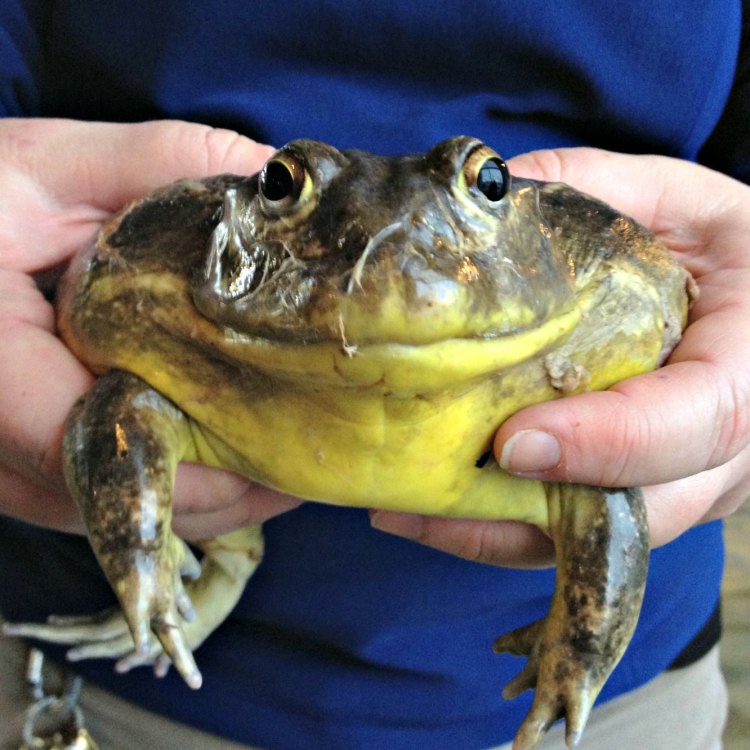
Lithobates catesbeianus
The Mighty Bullfrog: A Powerhouse of the Amphibian World
The world of amphibians is full of unique creatures, each with its own fascinating features and behaviors. Among them stands the mighty bullfrog, a creature known for its loud call, large size, and powerful hind legs. Despite its popularity, there is still much to learn about this remarkable amphibian. In this article, we will delve into the world of bullfrogs, examining their physical characteristics, behaviors, threats, and conservation efforts PeaceOfAnimals.Com.Adult Size: A Giant in the Amphibian World
The bullfrog (Lithobates catesbeianus) is a true titan in the amphibian world, measuring an impressive 6-8 inches (15-20 cm) in length. This size makes them one of the largest frogs in North America, second only to the American bullfrog. However, unlike their close relative, bullfrogs have a more robust and round body, making them easily distinguishable.
In addition to their large size, bullfrogs also possess powerful hind legs, which allow them to jump long distances and catch prey. These legs are covered in webbed feet, aiding in swimming and making them efficient in both land and water.
Average Lifespan: A Decade of Existence
The lifespan of a bullfrog varies depending on their habitat and environmental conditions. On average, they can live for 5-10 years, with some individuals living up to 15 years in captivity. However, in the wild, they face various threats that can greatly impact their lifespan.
Reproduction: The Circle of Life
Bullfrogs are sexually reproductive creatures, meaning they require a male and female to reproduce Black Dragon Lizard. Like most amphibians, they undergo a metamorphosis from tadpoles to adults. Female bullfrogs lay their eggs in shallow water, usually in large clusters, which can contain up to 20,000 eggs.
After about 10 days, these eggs hatch into tadpoles, which spend the next few months developing and growing. Once fully developed, they undergo metamorphosis, and the tiny tadpoles transform into adult bullfrogs.
Reproductive Behavior: Laying Eggs and Serenading Mates
One of the most defining behaviors of bullfrogs is their loud, deep-pitched call. This call is primarily used to attract mates during the spring and summer breeding season. However, their call has also been observed during other times of the year, usually in a territorial display.
In addition to their calls, male bullfrogs also have a unique characteristic – a yellow throat. This bright color serves as a visual cue to females, indicating their reproductive readiness.
Sound or Call: Can You Hear Me?
The male bullfrog's call has been described as a loud, low-pitched "jug-o-rum," which can be heard from over 100 yards away. This call is produced by a vocal sac located under their chin, which amplifies the sound. It is used to attract females and sometimes as a display of aggression towards other males.
Migration Pattern: Sticking to Home
Unlike some other amphibians, bullfrogs do not migrate. They tend to stay in one area, only moving to find suitable habitats or during their breeding season. This non-migratory behavior makes them vulnerable to threats as their habitat gets destroyed or polluted.
Social Groups: A Solitary Life
Bullfrogs are solitary creatures, preferring to hunt, rest, and bask alone. However, during the breeding season, they will gather in large groups near the water's edge, calling for mates.
Behavior: A Nocturnal and Territorial Lifestyle
As nocturnal creatures, bullfrogs do most of their hunting at night. They are opportunistic feeders, preying on insects, smaller frogs, tadpoles, and even small mammals. Their large size allows them to eat prey that is almost their own size, making them formidable predators in their environment.
Bullfrogs are also territorial animals, often defending their chosen areas from other bullfrogs and predators. They are known to aggressively chase away intruders from their territory, including other frogs, snakes, and even larger predators.
Threats: A Battle Against Habitat Loss, Pollution, and Predation
Like many amphibians, bullfrogs face numerous threats that impact their population and survival. Habitat loss and destruction rank as the primary threat, as urbanization and agricultural activities continue to encroach on their natural habitats. This destruction leads to a loss of breeding sites, food sources, and shelter, causing a decline in their population.
Pollution is another significant threat to bullfrogs. Pesticides, fertilizers, and other chemicals used in agriculture and urban areas can make their way into water bodies, causing harm to their delicate skin and affecting their development. In addition, contaminants can also disrupt their food chain, leading to a decline in their prey and ultimately, their own population.
Predation is another factor that affects bullfrog populations. As predators themselves, bullfrogs are essential in controlling insect populations. However, they also have their own set of predators, including snakes, birds, and mammals.
Conservation Status: Least Concern, But Still a Cause for Concern
The bullfrog is currently listed by the IUCN as least concern due to its wide distribution and large population. However, this does not mean that they are entirely safe from extinction. In many regions, their populations are declining due to various threats. As a result, conservation efforts are being put in place to monitor and protect their habitats.
Impact on Ecosystem: A Double-Edged Sword
As predators, bullfrogs play an essential role in controlling insect populations, making them a vital part of their ecosystems. However, their large size and voracious appetite also make them a threat to native species. In some areas, bullfrogs have been introduced by humans to control insect populations, but their presence has caused imbalances in native ecosystems.
Human Use: From Food to Scientific Research to Pet Trade
Humans have long interacted with bullfrogs, with some cultures viewing them as a delicacy and a source of food. In addition, bullfrogs are also used for scientific research, as they are commonly used in studies related to ecology, pollution, and the impact of urbanization on wildlife.
Their large size and unique features also make them popular in the pet trade. However, it is essential to keep in mind that wild animals are not meant to be kept as pets and should be left in their natural habitats to thrive.
Distinctive Features: The Mighty Bullfrog
Bullfrogs are easily distinguishable from other frogs due to their large size, powerful hind legs, and webbed feet. Their loud call also sets them apart from other amphibians in their environment. However, one of their most distinctive features is their ability to consume prey larger than themselves, defying the limits of their size.
Interesting Facts: The Bullfrog Chronicles
In addition to their impressive capabilities, bullfrogs also have some interesting facts that are worth mentioning:
- Bullfrogs have been known to remain dormant in the mud for long periods to survive harsh conditions.
- They have been observed to push their heads above the water's surface while keeping their bodies submerged to avoid detection by predators.
- The bullfrog's skin produces a slimy mucus that contains chemicals that act as a defense mechanism against predators.
- Bullfrogs have a unique ability to absorb moisture through their skin, allowing them to survive in drier regions.
Predator: A Matter of Survival
As mentioned earlier, bullfrogs themselves face predation from various species, including snakes, birds, and mammals. This predator-prey relationship is an essential aspect of their ecosystem, ensuring a balance in populations.
A Fascinating Creature to be Appreciated and Protected
The bullfrog is truly a remarkable creature, with its large size, powerful legs, and unique behaviors. However, as with many amphibians, their populations are facing threats from habitat loss, pollution, and predation. It is crucial for us to understand and appreciate these fascinating creatures while also taking steps to protect them.
As individuals, we can play our part in conservation efforts by reducing our impact on the environment, such as limiting the use of pesticides and promoting sustainable living practices. By working together, we can ensure that the mighty bullfrog remains a powerful presence in our ecosystems for years to come.
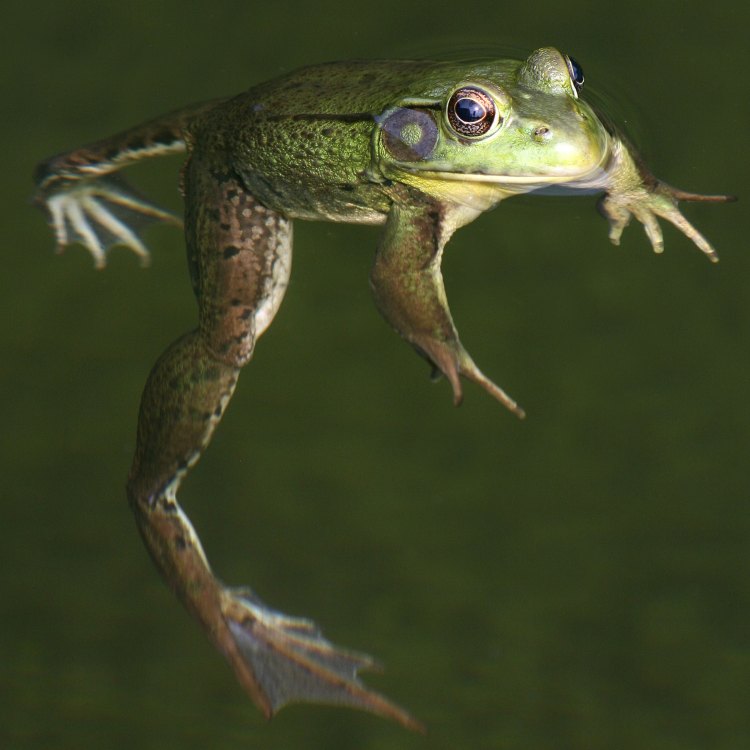
The Mighty Bullfrog: The Powerful Amphibian of North and South America
Disclaimer: The content provided is for informational purposes only. We cannot guarantee the accuracy of the information on this page 100%. All information provided here may change without prior notice.


